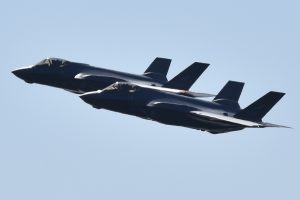The pandemic may have delayed its theatrical release, but 80s kids and plane nerds alike have at least been able to pour over the trailers for Top Gun: Maverick. Aside from the obligatory motorcycling and volleyball shots, they show off a range of combat aircraft: a classic P-51 Mustang, the original film’s F-14 Tomcat, and a presumably fictional jet that resembles the rumored Aurora hypersonic spy plane.
But the main aircraft we see throughout is the Boeing F/A-18 Super Hornet. As the mainstay of American naval aviation, that is not hugely surprising. But one might also wonder why Top Gun — famously a property that exists hand-in-glove with Navy recruitment efforts — would eschew the chance to show off the latest (if delayed and over-budget) naval fighter, the F-35C Lightning II.
It turns out that the primary reason is Maverick himself. In keeping with his usual practice of performing as many of his own stunts as humanly possible, Tom Cruise insisted on flying in an actual fighter aircraft. And since there is no two-seat version of the Lightning, and with neither the Navy nor the studio particularly keen to strap Cruise solo into a $120 million jet and catapult him off the USS Abraham Lincoln, the Super Hornet was the only option.
But why isn’t there a two-seat F-35? In fact, it’s part of a broader trend. While a number of 4th and 4++ generation two-seaters remain in production — including the Dassault Rafale, the Eurofighter Typhoon, the Boeing F-15 Eagle, and the Sukhoi Flanker — none of the newest, most sophisticated 5th generation fighters is known to have even a proposed two-seat variant.
Why not? One issue is that, historically, two-seat versions have often been used primarily as conversion trainers. In this model, pilots being moved into higher-performance jets take their first flights in two-seater versions with an experienced instructor pilot with their own set of controls to prevent aircraft or crew losses. But fighter aircrafts have become exponentially more expensive: In 1965, an F-4 Phantom cost about $2 million (about $20 million in today’s dollars), roughly a fifth of the flyaway cost of a Lightning. And in addition to costing more to simply engineer, a two-seat F-35 would have to be combat-capable; costs are already so high that most air forces can only afford enough jets to support a handful of operational squadrons even before accidental or combat losses. There is no room in today’s military budgets for fighter jets that can’t fight.
On the other hand, the rarity of these jets — and the increasing quality of simulators — means that they can be assigned exclusively to the most experienced and capable pilots. Other modern high-performance aircraft like the F-22 Raptor have entered service successfully without a trainer variant.
But training was never the only reason fighters were designed with a back seat. Planes like Maverick’s old F-14 Tomcat had a second crew member on board to handle their complex sensor, communications and weapons systems while the pilot focused on flying. Certainly, automation, more sophisticated flight controls and sensor fusion have reduced elements of pilot workload, opening up their attention for other tasks. But the environment new planes will be expected to fly and fight in has not gotten simpler.
So a new concept of operations has begun to emerge around the constraints of extremely expensive aircraft and the possibilities unlocked by automation: the “loyal wingman.” The idea is that one or more cheap, more or less expendable drones would accompany a fighter, carrying a far greater weapons or sensor payload than the piloted plane could alone. In this conception the fighter pilot is less a duelist and more a quarterback, with the drones taking on much of the physical risk of combat.
But if that is the direction that combat aircraft are heading, it seems shortsighted to make new fighter jets exclusively single-seaters. Even with sensor fusion and control automation, flying is still a full-time job. And given that sensors are getting more sophisticated and long-range missiles ever-more capable, there is an argument for adding a second crew member to manage data and exercise oversight of autonomous units even if it makes the plane somewhat less maneuverable. Yet that does not seem to be the direction things are going; one of the commonalities of announced fifth- and sixth-generation fighter aircraft seems to be making the pilot optional rather than adding a back-seater. That trend, in turn, will push ever-greater responsibility onto the machines while cutting down the amount of human attention available to supervise them.
The U.S. Air Force made a surprise announcement last week that it had already constructed and flown a prototype of its next generation fighter, but details of the aircraft — including its crew complement — were not forthcoming. It would be a surprise to find that a second seat was part of the design, but it would be worth considering. And Maverick might even agree.

































